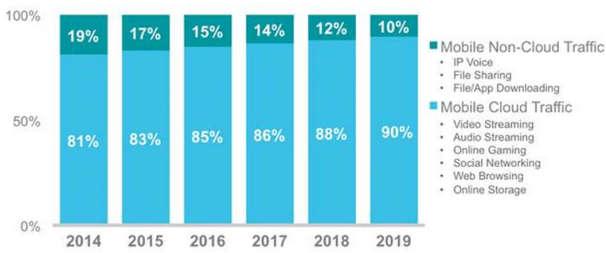The rising trend of smartphones used globally leads to an enormous rise in the amount of applications that are used on them. The latest forecast estimates that by the end of 2020, the mobile app industry will rise to $100 billion.
Mobile apps have been developed not only for smartphones, but also for IoT-enabled devices, wearables, smart homes & cars, etc. We foresee a huge opportunity in this new upcoming ecosystem. The importance of sharing and synchronizing data in real time with the server and other devices is growing, so cloud based apps are also driving innovations in 2017.
Now let’s summarize the main trends in mobile app development in 2017.
Cloud mobile technologies
According to Cisco research, 90% of total mobile data traffic will be driven by cloud apps by 2019.

Cloud mobile technology synchronizes different platforms and various mobile devices. All you need is an internet connection to access a mobile app and all needed data on any mobile device, so it makes the process of launching an app faster and less expensive.
Mobile app security
A growing range of devices store and manage sensitive business and personal data, so mobile security is becoming increasingly crucial due to user’s desire for confidentiality and information security.
Gartner predicts that 75% of total mobile apps would not pass entry-level security tests.
Mobile applications with in-built security options at the API level or with a code to have access to it (without exposing companies or application users to unnecessary risks) are becoming prioritized in all business areas nowadays.
Mobile Internet of Things
Nowadays, mobile apps are among the primary solutions used as a management tool in the IoT. The integration of mobile apps and IoT is one of a major boom right now with IoT mobile apps range from transportation and telecommunications to healthcare and security.
Sensors, connected devices, and wearables are parts of the IoT ecosystem and insights on how to develop these technologies for changing connected experiences for your customers and employees will drive your business forward.
Mobile IoT is not just an application, it is about the creation of a seamless experience with interfaces across all connected devices. Generating this integration unlocks the huge potential of mobile and IoT for transformations in various businesses .
Beacons & Location Based Services
Using location technology to target and engage customers is becoming one of the main trends when using GPS, Wi-Fi or Beacons. All of the available tools give you opportunities to provide highly dedicated service to your clients, based on their real-time location.
With the ease of access and use of GPS on all mobile devices today, location-based services (LBS) will progressively transform to provide users with real-time data.
The growing demand for such services will expand to navigation, retail offers, indoor mapping, security features, tourism, payment portals and more, but since such services drain battery very fast, hardware solutions in this area will be required to enable the boost in development.
Mobile UX
Mobile app UX and design will be transformed by chatbot and artificial intelligence in 2017.
From pizza ordering with a conversational interface in a mobile app to retail banking, we’ll see this technology implementation in other industries with endless opportunities form different approaches and applications.
Trends on chatbot applications development are the following:
- App Problem
- Messaging
App problem
The chatbots provide an extra level flexibility for every user. Lots of apps perform such options as booking tickets, hailing a taxi or getting the best deal in booking flights, but you will waste your time making many clicks in every such application. On the other hand, chatbots will do the same with the use of a single message.
Thus, you won’t have to overload your smartphone with too many apps. With chatbot platform customers will interact with the business, even without downloading an application.
Messaging
Based on latest data provided by Statista, a messaging app is one of 5 applications used every day in the US. The chatbots rise is on account of this increase in usage of messaging. The number of users in messaging apps will increase to 2.10 billion. Therefore, the chatbots’ development idea is to adopt more functionality and flexibility into messaging.

